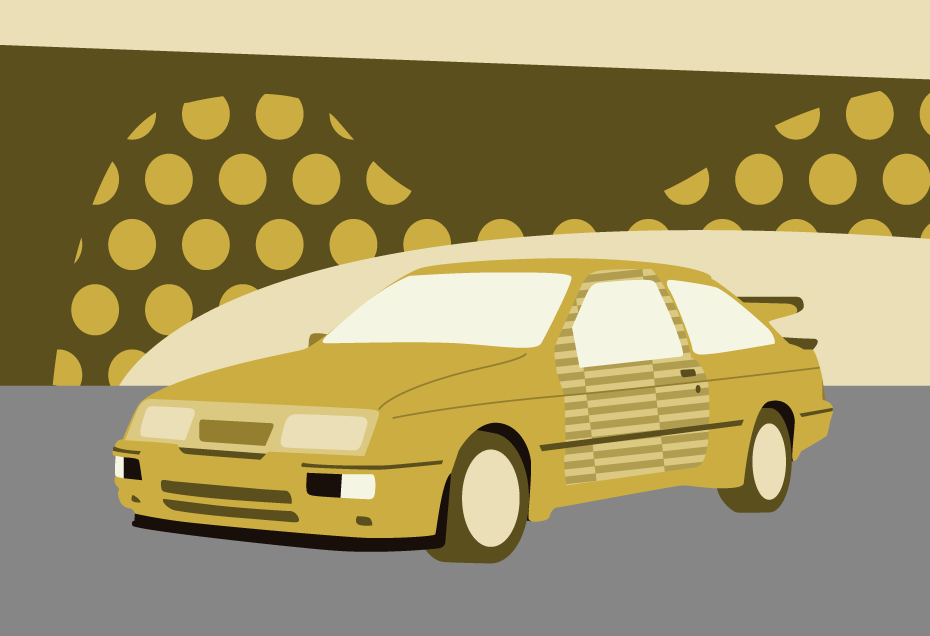Outrageous, sensational, dramatic, exhilarating, extraordinary.
Just a few of the adjectives committed to print when the Ford Sierra RS Cosworth burst onto the scene with an extravagant swagger in 1986.
Billed as the most exciting Ford since the GT40, the whale-tailed flyer didn’t disappoint.
We look at its history.
The Ford Sierra RS Cosworth was created for one reason only – to return the blue oval to the frontline of touring car racing.
It did just that, especially in its upgraded RS500 form, but it also spawned a homologated road car that turned a humble family hatchback and rep’s favourite into a supercar contender.

Its other-worldly appearance made everyone sit up and take notice, but the transformation was largely down to the Cosworth-engineered powerplant, a heavily-modified version of Ford’s four-cylinder Pinto unit.
Before we examine the guts of this extraordinary engine, let’s go back to the beginning and look at how this hottest of Sierras came about.
Sierra Cosworth development
When Stuart Turner was appointed head of Ford Motorsport in Europe in spring 1983, he knew he needed a new car to get the company back to the top of touring car racing.
That car would be based on the Sierra, launched in 1982 to a mixed reception but boasting rear wheel drive and a comparatively slippery body thanks to its then-controversial ‘jelly mould’ shape.

He gained the support of PR guru Walter Hayes, who had played a leading role in pushing both the Le Mans-winning GT40 project and the development of the all-conquering Cosworth DFV engine, and Ken Kohrs, vice-president of development.
They visited Cosworth, where engineers had independently developed the YAA engine, a twin-cam, 16-valve unit based on the T88, or Pinto, block.
It was exactly what they were looking for to power the racing Sierra, and Ford officially requested 5,000 turbocharged versions (designated YBB), the number required for Group A homologation.

In the end, Ford had to agree to Cosworth’s demands to accept no fewer than 15,000 units. The extra 10,000 would eventually be put to good use…
Cosworth engine
Ford had been collaborating with Cosworth for 25 years, but the Sierra was the first to bear the company’s name – and for good reason.
The YBB engine succeeded in turning this unassuming hatchback into a track warrior and road rocket. So how did they do it?
A 16-valve, belt-driven twin-cam aluminium head was fitted to the Pinto block, with a Garrett AiResearch T3B turbo fed with an air-chilled intercooler taking output to 204bhp and 205lb ft of torque (more than 300bhp in competition form).

Mahle pistons were fitted and joined to forged steel conrods and a Cosworth-designed crankshaft, while other modifications included a new oil pump, unique cast aluminium sump and an all-new light alloy cylinder head.
Fuel was fed via a Weber injection set-up, with Magneti Marelli programmed ignition.
To find a suitable gearbox, Ford looked to the five-speed Borg-Warner T5 used in the Mustang, among others, with modifications to suit the higher-revving Cosworth engine.
The car’s suspension was largely standard Sierra – MacPherson struts and coil sprung trailing arms – but modified to reduce roll and improve stability.
Many of the suspension changes were a legacy of Andy Rouse’s Sierra XR4Ti, which he successfully campaigned in the 1985 British Saloon Car Championship.
Like our illustration of the Ford Sierra RS Cosworth: in a class of its own at the beginning of the article?
Download a free high-quality poster version here.
Body modifications
So much for what’s under the skin, what about the skin itself? A total of 92 modifications were made to the standard Sierra’s bodywork, overseen by Lothar Pinske of Ford’s Special Vehicle Engineering division.
Pinske, only too aware that the Sierra’s hatchback body was prone to aerodynamic lift, was determined there would be no compromises when it came to keeping the car pinned to the road.
The answer was that enormous rear spoiler, supported by a central spar, deemed the only way of keeping the Cosworth grounded at racing speeds of up to 185mph.

Because no bodywork modifications were allowed in Group A, it also had to be fitted to the road car, much to the consternation of Ford’s top brass.
Hayes took up the cause, lobbying management to proceed with the car – whale tail and all – and Pinske was eventually given the go ahead to make a production version based on his prototype.
Other significant body changes included wider wheel arches to take 10in racing tyres; a large front air dam housing three scoops; spats and sill extensions on the flanks; bonnet slats to expel excess air; and a brick-sized slot punched between the headlights.

It may have all looked a little over-the-top, but it all worked – the Sierra RS Cosworth was the first road car with positive downforce, with class-leading roadholding.
On the inside, the car was much more conservative, marked out by Recaro seats, a small leather-bound steering wheel and a turbo boost gauge set in the XR4 instrument pack.

In an effort to keep costs down, the Cosworth was available in just three colours – black, white and moonstone blue – and just two equipment options: with or without central locking and electric window lifts.
Launch and on the road
The first road tests appeared in January 1986, and left readers – and potential buyers – in no doubt that Ford had produced something very special.
Here was a car with the practicality of a family hatchback, and the performance of a Ferrari Berlinetta Boxer.
The ‘Cossie’ could break 60mph in a little over six seconds and keep going to 150mph.

MotorSport magazine’s Mike Lawrence, who took a Cosworth for a high-speed test in Spain in December ‘85, hailed a “car in a class of its own”, “quite simply the best high performance saloon in the world”.
“Even though I drove the car extremely fast by most standards, I came nowhere near exploring the limits of roadholding,” he wrote.
“Over and above any description of its characteristics, this car has a wonderful feel, it’s an indescribable pleasure to drive.
“A lot of money has gone into development and common sense says that running off just 5,000 examples would be a lost opportunity. My guess is that Uncle Henry has a few more tricks up his sleeve.”
More on that later.
CAR magazine thought that Batman would feel at home in a black Sierra Cosworth, and would make good use of its “exhilarating” performance.
“What really impresses is the way the car reels in the horizon with undiminished zeal once you have reached 110mph,” it wrote. “Use the revs to the full and the car accelerates consistently, its turbocharger unbetrayed.”

With more than 80 per cent of maximum torque available between 2,300 and 6,500rpm, the Cosworth also “doesn’t mind a lazy drive at low revs in a high gear”.
At £16,000, the Sierra outguns everything in its price range, and even the £18,000 BMW M535i falls short. The Cossie was out on its own.
Autocar described “quite an extraordinary vehicle”, while MotorSport’s Lawrence – testing the car again for the October 1986 issue – once more waxed lyrical.
“We have yet to see the car in competition, for it is not yet homologated, but as a road car it is sensational,” he wrote. “You can drive for a week and not come across a car which will match it.
“For the price there is nothing else available which combines so much performance and driving appeal while being sufficiently practical to use as a family’s main vehicle.”
Ford Sierra Cosworth RS500
The ultimate version of the Cosworth three-door hatchback was the mighty RS500, built to make the car all-conquering on the racetrack.
As well as the 5,000 vehicles (actually 5052) required for homologation, Ford set aside an additional 500 cars to take advantage of the FIA’s 10 per cent “evolution” ruling.

Aimed at the 1987 World Touring Car championship (WTCC) , Ford needed to have the car homologated by July, but lacked the internal flexibility to carry out the work.
The job of converting the car was handed to Tickford, which had all 500 cars ready for inspection on July 30 – in time for the RS500 to win four of the final six rounds of that year’s WTCC, filling four of the top six places in the championship overall.
Each of the 500 cars started life as a fully-built Sierra Cosworth, with Tickford stripping them down and carrying out a range of modifications.
The engine, designated YBD, gained a 20bhp hike to 224bhp, with race-tuned cars achieving a then-staggering 500bhp.

Changes included a stiffer cylinder block to cope with the rigours of racing, a larger Garrett T04 turbocharger with larger intercooler, a second set of four Weber IW025 “yellow” fuel injectors, and uprated fuel pump, oil and cooling systems.
The big rear spoiler gained a 30mm extension and a second spoiler was placed on the boot lid, significantly improving downforce, while a reprofiled front bumper featured a splitter for better front downforce, and enlarged air inlets to aid cooling.
Stability was further enhanced by revising the pivot points for the semi-trailing rear suspension.
Adrian Flux Classic Car Insurance
MotorSport’s deputy editor Gordon Cruickshank wrote: “The RS500 runs like a torpedo for the horizon, and the faster it goes the more dogged its aim.”
The car, made in right hand drive only and costing £19,950, was only available through the 90 specialist Ford Rallye-Sport dealers in Britain.
These days, a good example will set you back from £80,000 to £100,000…
RS500 in motorsport
After those late wins in the ‘87 WTCC, the RS500 went on to become the car to beat all over the world, winning touring car titles in Germany, Japan, Australia, New Zealand and Britain.
It also won the 24 Hours of Spa in 1989, the Bathurst 1,000 twice, and the RAC Tourist Trophy.
With Group B cars banned from rallying at the end of 1986, the Group A RS500 was also pressed into service as a rally car but, with only rear wheel drive, suffered on loose surfaces against its all-wheel-drive competitors.
Nevertheless, the car regularly placed in the top five, and won the Corsica round of the ‘88 World Rally Championship outright.
Rob Gravett, who won the 1990 BTCC in an RS500 with nine wins in 13 races, said the Cosworth was “a great car to drive and stunningly quick”.

“I don’t think people realise just how fast the Cosworths were. At Bathurst in ’89, we pulled 189mph down the Conrod Straight, and in the 1990 500km race at Fuji my team-mate Stefan Johansson and I were in the 190s. That’s still pretty remarkable.”
Sierra Sapphire RS Cosworth
Remember those extra 10,000 engines Ford was obliged to take from Cosworth?
They, and a lot more besides, ended up in the less ostentatious second generation car, based on the four-door Sierra Sapphire saloon.

This was more understated super-saloon than wild hot hatch.
It was the first mass-produced Cosworth, manufactured from 1988 to 1989 in Genk with YBB engines imported from the UK.
A more grown-up car than its predecessor, the suspension set-up in the Sapphire Cosworth favoured a smoother ride and was easier to handle for less “professional” drivers.
It also had a lower drag coefficient, leading to marginally improved performance, hitting 60mph in just 6.1 seconds with a top speed of 150mph.
MotorSport’s Cruickshank, writing in the March 1988 issue, said that “fitting the Cosworth running gear into a Sapphire Ghia shell has transformed the character of the car”.
Its three-box shape gave improved rigidity, while “other mainstream Sierra improvements such as larger windows and better sealing and insulation go together with refinements to the suspension to make a much more relaxing car which is virtually as responsive on the road”.
Ford had succeeded in pushing the Sapphire Cosworth away from the road-racer image and towards that of a fast all-round five-seater – it was “better car”, according to Cruickshank.
“Yet there was an appeal in that raw homologation special idea which I think I shall miss,” he added.
In all, 13,140 were sold, the most successful version produced.
Last hurrah: the 4×4 Cosworth
If the Cosworth was to succeed on the rally circuit, it needed four wheel drive, and so the final evolution of the Sierra Cosworth was launched in January 1990.
The distinctive bonnet vents from the early cars were back, and underneath Ford said that 80 per cent of the engine was either re-engineered or replaced.

Now called YBG (or YBJ for those without a catalytic converter), the engine pushed out an increased 220bhp to cope with the extra 100kg of weight from the four-wheel-drive system.
It kept performance similar to previous models, with 60mph reached in 6.2 seconds, enough to wipe the smile off the face of a Porsche 944 S2 driver.
CAR magazine wrote: “Once the Ford is rolling, power delivery is seamless. Devastating, too. You don’t need to see figures to realise this is a stunningly quick car – it hurls you towards the horizon with a zeal approaching violence.
“There’s a sense of occasion about driving the Cosworth, a feeling that it’s out of the ordinary.
It’s the supercar bargain of the moment.”
It was, again, a hit with buyers, with 12,250 cars sold between 1990 and 1992, but it never hit the heights as a rally car, failing to win a World Rally Championship event despite coming close on several occasions.
With the Sierra set to be replaced by the Mondeo in 1993, Ford’s motorsport ambitions switched to the Escort Cosworth.
It was the end of an era for the everyman’s supercar.
Owner’s story: read about Phil Holmes’ adventures in his Cosworth.






